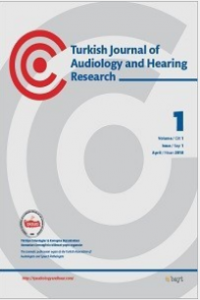Çocuklarda Eşdeğer Kulak Kanalı Hacmi Değerlerinin Yaşa Göre Değişiminin İncelenmesi
Amaç: Bu çalışmanın amacı, eşdeğer kulak kanal hacminin pediatrik grupta yaşa bağlı değişiminin belirlenmesidir. Gereç ve Yöntem: Çalışmaya 1-8 yaş arası 60 birey 120 kulak dahil edilmiştir. Katılımcılar her grupta 30 birey olmak üzere iki grupta değerlendirilmiştir; Grup I’in yaş aralığı 1-4 iken Grup II’nin yaş aralığı 5-8 olarak belirlenmiştir. İşitmesi normal olan tüm bireylere otolojik muayene sonrasında immitansmetrik ölçümler uygulanmıştır. Bulgular: Grup I ve Grup II’nin ölçülen eşdeğer kulak kanalı hacmi değerleri farkı istatistiksel olarak anlamlı bulunmuştur p
Anahtar Kelimeler:
eşdeğer kulak kanalı hacmi, immitans, timpanometri, dış kulak yolu, kulak kanalı
Analysis The Changes of Equivalent Ear Canal Volume Measured in Normal Hearing Children According to Age
Objective: The aim of this study was to determine the age-related change of equivalent ear canal volume in the pediatric group. Materials and Methods: Sixty individuals 120 ears aged between 1 and 8 years were included in the study. Participants were evaluated in two groups as 30 individuals in each group; The age range of Group I is 1-4 and the age range of Group II is 5-8. After the otologic examination, immitansmetric measurements were applied to all individuals with normal hearing. Results: The difference between the measured ear canal volume values of Group I and Group II was statistically significant p
Keywords:
Equivalent ear canal volume, immitance, tympanometry, ear canal,
___
- Alaerts, J., Luts, H., & Wouters, J. (2007). Evaluation of middle ear function in young children: clinical guidelines for the use of 226-and 1,000-Hz tympanometry. Otology & Neurotology, 28(6), 727-732.
- Bess, F. H., Miller, G., & Bratt, G. (1980). Unexplained conductive hearing loss. Southern medical journal, 73(3), 335-338.
- Feigin, J. A., Kopun, J. G., Stelmachowicz, P. G., & Gorga, M. P. (1989). Probetube microphone measures of ear-canal sound pressure levels in infants and children. Ear and Hearing, 10(4), 254-258.
- Gelfand, S. A. (2007). Essentials of audiology: New York: Thieme, 2007. Hunter, L. L., & Shahnaz, N. (2013). Acoustic immittance measures: Basic and advanced practice: Plural Publishing.
- Katz, J., Medwetsky, L., Burkard, R. F., & Hood, L. J. (2009). Handbook of clinical audiology: Wolters Kluwer, Lippincott William & Wilkins.
- Keefe, D. H., Folsom, R. C., Gorga, M. P., Vohr, B. R., Bulen, J. C., & Norton, S. J. (2000). Identification of neonatal hearing impairment: Ear-canal measurements of acoustic admittance and reflectance in neonates. Ear and Hearing, 21(5), 443-461.
- Margolis, R. H., & Heller, J. W. (1987). Screening tympanometry: criteria for medical referral: original papers. Audiology, 26(4), 197-208.
- Nozza, R. J., Bluestone, C. D., Kardatzke, D., & Bachman, R. (1992). Towards the Validation of Aural Acoustic: Immittance Measures for Diagnosis of: Middle Ear Effusion in Children. Ear and Hearing, 13(6), 442-453.
- Rosenfeld, R. M., Schwartz, S. R., Pynnonen, M. A., Tunkel, D. E., Hussey, H. M., Fichera, J. S., . . . Haskell, H. (2013). Clinical practice guideline: tympanostomy tubes in children. Otolaryngology—Head and Neck Surgery, 149(1_suppl), S1- S35.
- Shanks, J. E., Stelmachowicz, P. G., Beauchaine, K. L., & Schulte, L. (1992). Equivalent ear canal volumes in children pre-and post-tympanostomy tube insertion. Journal of Speech, Language, and Hearing Research, 35(4), 936- 941.
- Shanks, J. E., Wilson, R. H., & Jones, H. C. (1985). Earphone-coupling technique for measuring the temporal characteristics of aural acoustic-immittance devices. Journal of Speech, Language, and Hearing Research, 28(2), 305-308.
- ISSN: 2651-3757
- Başlangıç: 2018
- Yayıncı: Odyoloji Konuşma ve Ses Bozuklukları Derneği
Sayıdaki Diğer Makaleler
Akıcı Konuşma Bozukluğunda Terapi Etkinliğinin Objektif Ses Analizi İle Değerlendirilmesi
Bünyamin ÇILDIR, Özgül Akın ŞENKAL, Müzeyyen ÇİYİLTEPE
Çocuklarda Eşdeğer Kulak Kanalı Hacmi Değerlerinin Yaşa Göre Değişiminin İncelenmesi
Samet KILIÇ, Betül Çiçek ÇINAR, Gonca SENNAROĞLU
Aysun Parlak KOCABAY, Betül Çiçek ÇINAR, Merve Ozbal BATUK, Gonca SENNAROĞLU
Benign Paroksismal Pozisyonel Vertigo: Patofizyoloji, Değerlendirme ve Tanılama
Burak ÖZTÜRK, Münevver GÜLEÇ, Teslime Nur DEVECİ, Meryem Tuğçe GÜLER
Merve İKİZ, Merve Ozbal BATUK, Aysun Parlak KOCABAY, Betül Çiçek ÇINAR, Gonca SENNAROĞLU
